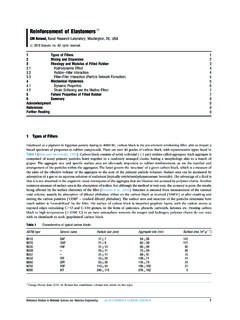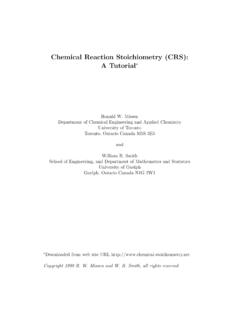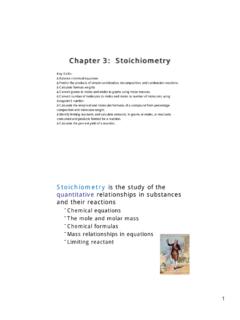Transcription of Segmental dynamics of polyurea: Effect of stoichiometry
1 Segmental dynamics of polyurea: Effect of stoichiometryD. Fragiadakisa, R. Gamacheb, Bogoslovova, Rolanda,*aNaval Research Laboratory, Code 6120, Washington DC 20375-5342, United StatesbNaval Surface Warfare Center, Research and Technology Dept., Indian Head, MD 20640-5035, United Statesarticle infoArticle history:Received 26 August 2009 Received in revised form9 November 2009 Accepted 13 November 2009 Available online 18 November 2009 Keywords:PolyureaBallistic coatingsSegmental dynamicsabstractWe study the Effect of variations in the soft/hard segment ratio, achieved through stoichiometry changes,in elastomeric polyurea. These variations have a marked Effect on the mechanical properties; however,the materials exhibit very similar glass transitions and local Segmental relaxation dynamics .
2 The latterdiffer only at elevated pressure, an increase in hard segment content associated with greater sensitivityto pressure and volume changes. In this respect the polyurea mimics the behavior found recently for anelastomer reinforced with hard filler particles. The resistance to ballistic penetration of the polyurea wasunaffected by the stoichiometry variations, consistent with the idea that the impact performance ofelastomers is governed by the Segmental dynamics rather than properties measured in conventionalmechanical by Elsevier IntroductionPolyurea is an attractive material for coating applications: itformsin situby the rapid reaction of isocyanates with polyamines,and its mechanical properties can be controlled over a broad rangeby varying the chemical structure and molecular weight of thecomponents and the relative amounts of isocyanate and amine ( ,the stoichiometry ).
3 Polyureas exhibit a phase separated structuresimilar to that of segmented polyurethanes, with rigid isocyanatedomains (hard phase) embedded within a matrix of flexible chains(soft phase)[1]. Extensive intermolecular hydrogen bonding ofpolyurea typically leads to high mechanical recent application of elastomeric coatings is to improve theresistance of hard substrates to fragmentation[2] and ballisticpenetration[3]. The mechanism of impact mitigation from elas-tomer coatings is incompletely understood, but an importantcontribution to the coatings effectiveness is their ability to tran-sition to the glassy state during the deformation[4]. This means thesegmental relaxation times of the coating are on the order of theinverse of the strain rate during impact; this strain rate (estimatedas the ratio of the ballistic velocity to polymer thickness) can be ashigh as 105s 1or more.
4 The viscoelastic rubber-to-glass transitionis accompanied by large energy absorption, which thus toughens the polyurea has been successfully employed as animpact coating and in order to understand and optimizeperformance, a number of studies have been carried out to char-acterize its viscoelastic behavior[5 9], as well as efforts to quantifyand model the behavior of the coatings[4,10 12]. However,modeling is challenging: on impact, the elastomeric coating issubjected to large strains in combination with large strain rates,and also experiences locally elevated hydrostatic pressure thatchanges the viscoelastic an impact-induced glass transition plays a major role in theperformance of polyurea coatings, it is important to characterizethe Segmental dynamics of the soft phase, which controls thistransition, as a function of both temperature and spectroscopy is an effective alternative to mechanicalmeasurements of the Segmental dynamics , since the former canprovide characterization over an extremely wide frequency rangeand also at elevated pressure.
5 A wide frequency range is especiallyimportant for polyureas since they exhibit an extremely broadsegmental relaxation, and time temperature superposition doesnot apply in the relevant viscoelastic regime[1]. The segmentalrelaxation times measured using dielectric spectroscopy areexpected to be proportional to those derived from dynamicmechanical measurements, although dielectricsare known to beslightly longer than relaxation times measured mechanically[13] .We recently characterized the viscoelastic properties of a polyureaas a function of temperature and pressure using dielectric spectroscopy[7]. The Segmental dynamics was found to conform to a scaling laws f TVg (1)with the material constantg for polyurea, whereVisthe specific volume. This scaling allows the prediction for arbitrary*Corresponding Roland).
6 Contents lists available atScienceDirectPolymerjournal homepage: $ see front matter Published by Elsevier 51 (2010) 178 184 Downloaded from pressure of the Segmental relaxation times, viscosities,and chain relaxation times from ambient pressure data, providedthe equation of state is available to interconverts(T,P) ands(T,V).The mechanical properties important for conventional applica-tions are very sensitive to stoichiometry : a 20% change in stoichi-ometry (corresponding to less than 3% difference in the weightfraction of isocyanate) results in significant qualitative change inthe mechanical behavior[5]. It is therefore of interest to examinethe Effect of stoichiometry on the Segmental relaxation of polyureaand its pressure dependence. In this work we study the segmentaldynamics of a series of polyureas with different stoichiometries,over a wide range of temperatures (213 353 K) and pressures( MPa 1 GPa), and assess their conformance to general behav-iors known for glass-forming liquids and polymers.
7 Ballistic testswere also carried out for two of the MaterialsThe polyureas were formed by reaction of a polycarbodiimide-modified diphenylmethane diisocyanate (Isonate 143L, DowChemical) and poly(tetramethylene )(Versalink P1000, Air Products). The molecular weight given by themanufacturer for the PTMO-amine component isM 1238 72 g/mol. The components were degassed under vacuum, mixed at roomtemperature, and molded between Teflon sheets. Curing wascarried out at room temperature for 8 h, followed by an additional12 h at 353 chemical structures of the diamine and isocyanate and ofthe resulting polyurea are shown inFig. 1. The stoichiometryspecified by the manufacturer, 96% (diamine/isocyanate by mole),corresponds to a 4:1 ratio of diamine to isocyanate by weight.
8 Threesamples with 86, 96 and 106% stoichiometry were prepared, andreferred to in the following as PU86, PU96 and PU106. Consideringthe urea linkage and the phenyl ring of the diamine end group aspart of the hard segment, the three polyureas have a hard segmentcontent of , and by weight, respectively. Unlessotherwise noted, the samples were dried prior to measurementunder vacuum for more than 48 h. We refer to such samples are dry , although trace amounts of residual water may still X-ray scattering profiles of a polyurea with thesame composition as PU96 showed peaks at wavenumbers nm 1[1]. These indicate a phase separated morphology ofrigid, semi-crystalline isocyanate domains in a polyether matrix,with an average interdomain spacing of 70 80 nm. The shape ofthe scattering curves is independent of temperature up to 360 K,with phase separation, crystal growth, and some ordering of thedomains transpiring at higher temperatures.
9 In this study werestrict our measurements to below 354 K and assume, in accordwith the reproducibility of dielectric measurements, that themicrophase structure remains unchanged within the temperatureand pressure range of our Experimental techniquesDielectric spectroscopy measurements were carried out usingparallel plate geometry with the sample in the form of a disk(15 20 mm diameter, mm thick). Spectra were obtained asa function ofTandPusing a Novocontrol Alpha analyzer (10 2 w106Hz). For ambient pressure measurements the temperaturewas controlled using a Delta Design model 9023 oven. For elevatedpressure the sample capacitor assembly was contained in a Man-ganin cell (Harwood Engineering) with pressure applied usinga hydraulic pump (Enerpac) in combination with a pressureintensifier (Harwood engineering).
10 Pressures were measured witha Sensotec tensometric transducer (150 kPa resolution). The sampleassembly was contained in a Tenney Jr. temperature chamber withcontrol to within K at the scanning calorimetry (DSC) measurements werecarried out using a TA Instruments Q100 with liquid nitrogencooling. Samples were equilibrated at 353 K for 15 min, then cooledat 10 K/min (or quenched, in the case of the neat diamine) to 123 capacity data were collected during subsequent heating at10 K/min, with glass transition temperatures defined as themidpoint of the heat capacity ballistic tests sheets (19 mm thick) of the polyurea weremounted to the front side of steel plates (5 mm thick high hardsteel , Mil-A-46100). The procedure followed Mil-Std-662F, caliber fragment-simulating projectile having a Rockwell Chardness 300.















